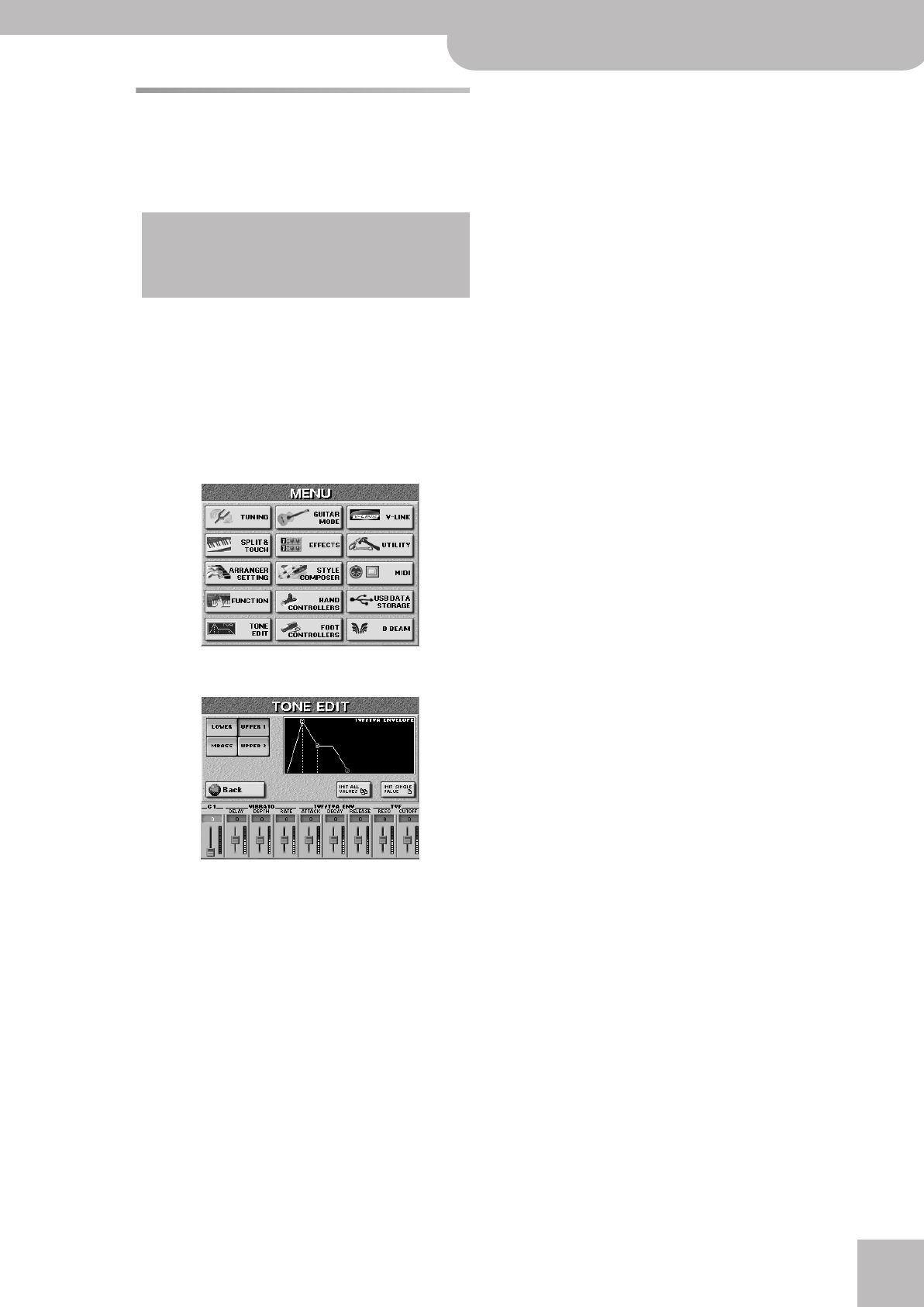
Tone Edit: editing Keyboard parts
E-60/E-50 Music Workstation
r
79
Tone Edit: editing Keyboard parts
Your E-60/E-50 allows you to edit certain parameters
that affect the way a Keyboard part sounds by adjust-
ing their brilliance, their modulation speed (Vibrato
Rate) and so on.
Assigning another Tone to a Keyboard part resets the
TONE EDIT parameters.
Note: All TONE EDIT parameters are relative parameters whose
values are added to or subtracted from the preset sound parame-
ter values. That is why you can specify both positive (“more”) and
negative (“less”) values.
Note: The TONE EDIT settings can be saved to a User Program.
(1) Press the [MENU] button.
The display changes to:
(2) Press the [TONE¥EDIT] field.
(3) Press the field of the Keyboard part you wish to
edit.
Note: Rather than performing steps (1)~(3), you could also
press and hold the corresponding TONE ASSIGN button.
(4) To quickly reset all parameters, press the
[INIT¥ALL¥VALUES] field.
(5) To reset only the selected parameter, press the
[INIT¥SINGLE¥VALUE] field.
(6) To edit one of the displayed parameters, press its
field.
Its “display” is now surrounded by a frame.
(7) Set the desired value with the [DATA÷ENTRY] dial or
the [DEC]/[INC] buttons.
Here are the parameters you can edit:
■C1
The function of this parameter depends on the sound
you assigned to the selected part. It may influence
the filter and resonance setting, switch between
organ samples with fast and slow Rotary modulation
(TONE [ORGAN] sounds), etc. Here’s an example:
select the “B3 Sermon” sound on page 1 of the
[ORGAN÷ACCORD] bank and use this function.
Note: The C1 parameter is only available for Tones that are
flagged with a tick in the “Parameter Reference” booklet.
■Modulation (Vibrato)
Vibrato is an effect created by modulating the pitch.
Pitch modulation adds a pleasant “wobble” to the
notes you play. Use the following three parameters if
you think the part in question has too much (or could
use a little more) vibrato.
Note: Some sounds already contain natural (sampled) vibrato
whose depth or speed cannot be changed.
● DELAY [–64~63]—This parameter adjusts the time
required for the vibrato effect to begin. Positive (+) set-
tings increase the time before vibrato will begin and
negative settings shorten the time.
● DEPTH [-64~63]—This parameter adjusts the intensity
of the pitch modulation. Positive (+) settings mean that
the “wobble” becomes more prominent, while negative
(–) settings make it shallower.
● RATE [-64~63]—This parameter adjusts the speed of the
pitch modulation. Positive (+) settings make the preset
pitch modulation faster and negative (–) settings make it
slower.
■TVF/TVA ENV (envelope)
The volume of an instrument changes over time,
from the moment the note begins to sound to when
it disappears. This change can be indicated on a
graph as shown in the display. The envelope shape is
unique to each instrument and is an important ele-
ment in how we distinguish the sounds we hear. The
envelopes of musical instrument sounds can change
depending on how the instrument is played. For
example if a trumpet is played sharply and strongly,
the attack will be quick and the sound will be sharp.
But if a trumpet is played lightly and softly, the
attack will be softer. In order to adjust the attack of a
sound, you can modify the ATTACK parameter of the
envelope.
The envelope parameters affect both the volume
(TVA) and the filter (TVF). The cutoff frequency will
rise as the envelope rises and fall as the envelope
falls.
● ATTACK [–64~63]—This parameter adjusts the onset of
the sound. Negative values speed up the attack, so that
the sound becomes more aggressive.
● DECAY [–64~63]—This parameter adjusts the time over
which the sound’s volume and Cutoff frequency fall
from the highest point of the attack down to the sustain
level.
Note: Percussive sounds usually have a sustain level of “0”.
Piano and guitar sounds are in this category. Holding the
keys for a long time will thus have little effect on the dura-
tion of the notes you are playing, even if you select a high
value here.
The parameters discussed here only apply to the fol-
lowing Keyboard parts: Upper1, Upper2, Lower, .Bass.
Be sure to select the part you wish to change before
actually editing it.
E-60_50_OM_UK.book Page 79 Thursday, June 22, 2006 10:06 AM
